|
†Serra da Capivara National Park and
Fundação Museu do Homem Americano (FUMDHAM), Brazil; *University
of Paris / University of Pernambuco; **Dept. of Earth Sciences, Université
Claude Bernard, Lyon; ~Centre National de la Recherche Scientifique (CNRS),
Biological Anthropology Laboratory, National Museum of Natural History, Paris,
France; ‡Dept. Nuclear Physics, Research School of Physical Sciences
and Engineering, Australian National University / Earth System Science
Department, Univ. California, Irvine ..
Pedra Furada
in northeastern Brazil represents possibly the oldest known human site in
the Americas. Since C-14 dates of 48-32,000 BP were reported in a Nature
article (Guidon and Delibrias 1986), the site’s Paleoindian components
have been highly controversial, challenged (though not refuted) by many North
American researchers (e.g. Meltzer, Adovasio, and Dillehay 1994). Yet the
site has solid evidence of non-Clovis, Paleoindian occupations including
human remains, plus a 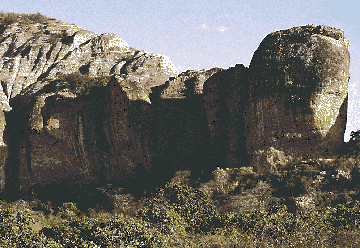 unique rock painting tradition from at least 12,000-6,000
BP. In March, 2002, Athena Review (AR) asked
archaeologist Niède Guidon and her colleagues to explain the current
status of the findings, including both Paleoindian skeletal and subsistence
remains, and the abundant rock paintings at Serra da Capivara National Park,
which contains Pedra Furada (figs.1,2). Much of the interview is given here
(for full text, see printed issue of AR, V3, no.2) unique rock painting tradition from at least 12,000-6,000
BP. In March, 2002, Athena Review (AR) asked
archaeologist Niède Guidon and her colleagues to explain the current
status of the findings, including both Paleoindian skeletal and subsistence
remains, and the abundant rock paintings at Serra da Capivara National Park,
which contains Pedra Furada (figs.1,2). Much of the interview is given here
(for full text, see printed issue of AR, V3, no.2)
Fig.1: Sandstone outcrops at Capivara National Park in Brazil, containing
the Pedra Furada Rock Shelter (photo: FUMDHAM).]
Dating of Pedra Furada:
AR: Based on your 1986 Nature article and several recent
web reports, your sites have a wide range of dates, some as early as 48-30,000
years BP with two hearth samples dated at 32,000 BP, and evidence of cave
painting (a fragment with two ochre-drawn lines) associated with a 17,000
year old C-14 dated hearth. How are these dates holding up as your work
progresses?
Niède Guidon: These dates are holding well. Once we
learned that the Department of Earth Sciences of the Australian National
University had developed a new chemical technique to decontaminate small
quantities of charcoal to be dated by AMS (accelerator mass spectrometry),
we sent samples to Canberra from the same charcoal dated in 1988/91 by the
Gif laboratory in France. The results are given here by Dr. Guaciara M. dos
Santos.
Guaciara dos Santos: A comprehensive chronology of human activity
at the Boqueirão da Pedra Furada (BPF) site, the oldest archaeological
site found at the Capivara National Park (fig.3), has been established by
reliable radiocarbon dates on charcoal excavated from different levels. The
sub-phase BPF 1, the lowest layer with definite evidence of human activity
in the Pedra Furada Rock Shelter, gave radiocarbon results ranging from 35,000
to greater than 48,000 BP (Guidon and Arnaud 1991; Parenti 1996). For the
oldest samples, the 48,000 lower limit is imposed by the residuals remaining
after conventional acid-wash or acid-base-acid
chemical pre-treatments. These pre-treatments are intended to decontaminate
samples with traces of extraneous, more modern carbon which may be present,
as the result of exposure of charcoal in this layer to the environment.
A new ABOX-SC (acid-base-wet oxidation followed by stepped combustion) procedure,
developed by Bird et al. (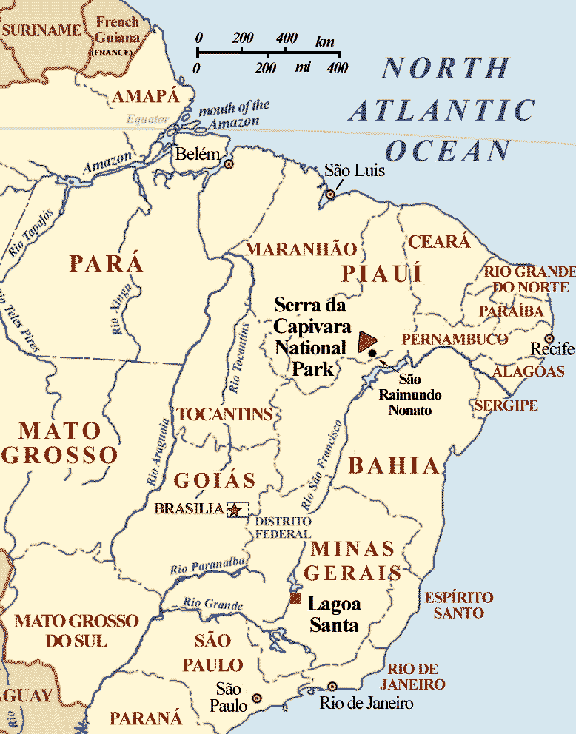 1999), which has been instrumental in establishing
secure radiocarbon dates of greater than 40,000 for the human occupation
of Australia (Turney et al. 2001), has now been applied by me to charcoal
from the oldest occupation layer of the Pedra Furada site. This more rigorous
chemical pre-treatment, which was followed by a stepped combustion (SC) procedure
to remove any residual contamination, decontaminates samples from charcoal
and wood (Bird et al. 1999; Santos et al. 2001), enabling credible radiocarbon
dating to around 55,000 BP. 1999), which has been instrumental in establishing
secure radiocarbon dates of greater than 40,000 for the human occupation
of Australia (Turney et al. 2001), has now been applied by me to charcoal
from the oldest occupation layer of the Pedra Furada site. This more rigorous
chemical pre-treatment, which was followed by a stepped combustion (SC) procedure
to remove any residual contamination, decontaminates samples from charcoal
and wood (Bird et al. 1999; Santos et al. 2001), enabling credible radiocarbon
dating to around 55,000 BP. Fig.2: Paleoindian site locations in east Brazil including Serra
da Capivara National Park and Lagoa Santa.
A total of seven charcoal samples from hearths at site BPF 1 were subjected
to the full ABOX-SC procedure and their radiocarbon contents were determined
by accelerator mass spectrometry at the Australian National University. Five
of the samples proved to be even beyond the limit of this new technique,
returning ages of greater than 56,000 BP. Finite ages of 53,000 and 55,000
BP were obtained for the remaining two (Santos et al., in manuscript).
These new results push back the time of human occupation at the Pedra Furada
site by at least another 8,000 years relative to the previous results. Hence,
it appears that humans were already at this site about 60,000 years ago,
and possibly even earlier.
Fabio Parenti: The radiocarbon dates at the site of Pedra Furada,
totaling 52 in my final report (Parenti, in press) are fully confirmed by
new AMS techniques, especially for the oldest unit, Pedra Furada 1, which
is now dated to at least 50,000 years BP.
Early Human and Subsistence Remains from Pedra Furada and Related
Sites:
AR: You reported in a web interview on finding human remains (3
fossilized teeth and a skull fragment) at Garrincho from about 15,000 years
old. How were they dated, and did they have any remarkable features?
Niède Guidon and Evelyne Peyre: The human teeth we dated
were found at a limestone site at Garrincho. The measured radiocarbon date
(Beta 136204) was 12,210 +/- 40 BP (Peyre et al. 2000; box 1). They are the
oldest human remains we have found until now. Presently we are waiting for
dates on 5 additional burials we excavated in December, 2001 in the entrance
of a limestone cave, underneath a wall with rock art.
The morphological features of these teeth were published in France (Peyre
et al. 1998). The most important aspects are as follows:
Incisor I: Based on its generally large shape and its compressed
appearance, this incisor can be considered to be archaic. Its wear pattern
(index of flattening), intermediate between that of the Neanderthals and
those observed in Europe at the end of the Late Pleistocene, or worldwide
in the Holocene, is equal to the Near Eastern Qafzeh people at the middle
of the Late Pleistocene. Like the latter, the compressed appearance results
in a strong buccal-lingual diameter, that has no equivalent since the end
of the Late Pleistocene except with the maximum recorded in the Australian
series. The large crown of this incisor, which is only surpassed by Wadjack
II (from Indonesia, at the beginning of the Holocene), resembles the averages
of men from the middle of the Late Pleistocene in Europe and the Near East,
and the most recent Australian series. It is, therefore, a type of modern
Homo sapiens, like the fossils at Qafzeh.
Molar 1: This molar is archaic, as much by its form which is very
slightly flattened, as by its large size. Its crown approaches the maximum
observed for most of the human remains since the end of the Late Pleistocene,
and is as large as the average of those observed in the middle of the Late
Pleistocene among the Neanderthals and modern humans at Qafzeh. Subsequently,
any series of equivalent averages are the exception, such as the European
series at Predmostí at the end of the Late Pleistocene and the Australian
series from the Holocene. The strong buccal-lingual diameter of this tooth
is, however, surpassed by certain fossils from the end of the Late Pleistocene
in Australia, and at the beginning of the Holocene in Indonesia (Wadjak I).
Its slight flattening, on the order of the present day averages of Africa
and Asia, recalls that of Predmostí and the Neanderthals. In conclusion,
the crown dimensions, both absolute and relative, of the Garrincho molar
are close to the averages seen in the middle of the Late Pleistocene.
Claude
Guérin: The cranial fragment from Garrincho consists of the
anterior-inferior (front lower) section of the left parietal bone. It is
remarkable for its thickness - an archaic trait - and for the presence of
a rare anomaly, a temporal-parietal, endo-exo cranial fossa (hole in bone
through which arteries pass). The teeth, as noted, consist of one I/1 (incisor)
which by its size and its compressed appearance render it archaic, and by
being remarkably well worn despite its youthful age. An M1 (molar) in a fragment
of the maxilla is archaic due to its large size and the fact that it is only
slightly flattened. It has an extra mesio-lingual root.
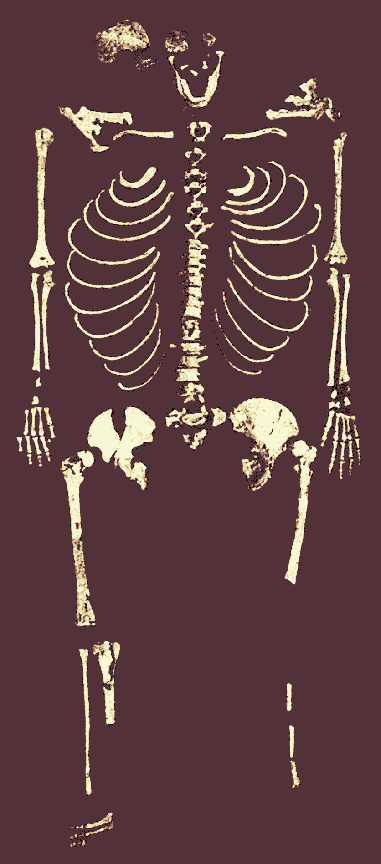 AR: In a recent (1999) paper by Guérin et al., a 9,700 year
old female skeleton (fig.3) was mentioned as being found at Toca da Janela
da Barra do Antonião near Serra da Capivara Park. What notable physical
features or archaeological associations does she have? Is she in any way
comparable to the (roughly contemporary) skeletal remains from the Logoa
Santa region (fig.2), including “Luzia” from Lapo Vermelha, or
others from Santana do Riacho 1 (Neves 2001; Chatters 2001)? AR: In a recent (1999) paper by Guérin et al., a 9,700 year
old female skeleton (fig.3) was mentioned as being found at Toca da Janela
da Barra do Antonião near Serra da Capivara Park. What notable physical
features or archaeological associations does she have? Is she in any way
comparable to the (roughly contemporary) skeletal remains from the Logoa
Santa region (fig.2), including “Luzia” from Lapo Vermelha, or
others from Santana do Riacho 1 (Neves 2001; Chatters 2001)?
Niède Guidon and Evelyne Peyre: These human remains
which we call the “Dame d’Antonião” (fig.3) were found
near a fire protected by stones. The burial and the skeleton were described
in 1993 (Peyre 1993). This woman, who well represents early South American
skeletons, has some archaic features. These include certain robust and archaic
cranial characteristics, such as the height of the mandibular symphysis (front
of the jaw), the rather small gonial angle (at the back of the jaw, between
the horizontally and vertically positioned bone), the large teeth, and the
average thickness of the cranial wall. Fig.3: Skeleton of “La Dame d’Antonião,” dated
at 9,670 + 140 BP and found at Toca da Janela da Barra do Antoniã
(photo: courtesy Evelyne Peyre).
Claude Guérin: The “Dame d’Antonião”
does have some archaic characteristics (like the thickness of the cranial
wall), but less so than the specimens from Garrincho, which is logical because
she is not as old. Like the 3 teeth and skull fragment from Garrincho, she
is associated with megafaunal remains (fig.5).
AR: What resources (i.e. plants, animals, raw materials for tools)
were available to Paleoindians in northeastern Brazil in the terminal
Pleistocene? Are there any new findings on what people were doing here and/or
refinements on the environmental reconstruction based on current fieldwork
and analysis?
Niède Guidon: Throughout the Pleistocene and until 9,000
BP, the mountains of this region were covered by rain forest. On the plains
were prairies and hundreds of lakes. Herds of American horses and paleo-llamas
lived there. The fauna was extremely rich and disappeared only at 6,000 BP.
The climate changed more or less after 9,000 BP. During our excavations we
found ancient river valleys, which until 9,000 BP were very big. The vegetation
also was rich. It is for these reasons that so many Indians lived here for
so long of a time. Actually our excavations are looking for detailed information
on the climate change and, chiefly, on the paleogeography of the region.
We are mapping all the changes the drainage system of the region had during
the last 30,000 years BP.
It was this opulence that permited these prehistoric people to develop a
very impressive culture, a high culture, not materially but spiritually.
We see this in the very elaborate paintings. Raw materials used for the lithic
industry were locally available flint, chalcedony, metaquartzite, and quartz.
As for recent environmental changes, until the arrival of the white colonists
there were rivers here. In 1970, the first time I came here, the river still
flowed, and in the town of São Raimundo Nonato there were big forests
and at least 10 lakes full of aquatic birds, with aquatic vegetation. Today
we have the caatinga, the dry forest; the river is dry and the lakes have
disappeared, covered by garbage so the owners could build houses on top of
them. The present-day poverty of northeastern Brazil is the result of 5 centuries
of bad agricultural technology and the destruction of the forests to sell
the wood.
Fabio Parenti: In the last 15 years, the main source of
palaeoclimatic information in São Raimundo Nonato region has been
the very rich mammalian faunal assemblages recovered in the caves of Precambrian
limestone outcrops. However, several new sources of data are currently under
study: charcoal from hearths and campfires of rock shelters, pollen from
coprolites and marsh sediments, speleothemes from limestone caves, and, from
nearby, Optico-Luminescence (OL) chronology of eolic dune fields in the São
Francisco region.
AR: We
are very intrigued about how your work and discoveries have contributed to
creating new paradigms about the earliest people in the New World. Now that
there are more definite preClovis sites, and there is mounting evidence that
some Paleoindians were not specialized big game hunters, but more generalized
hunters and gatherers, what kind of evidence for early subsistence is there
at Pedra Furada?
Niède Guidon: It seems, by the paintings, that they
used spearthrowers and not bows (fig.4). We think that they used spearthrowers
and traps to hunt.
At Pedra Furada we have found a lithic in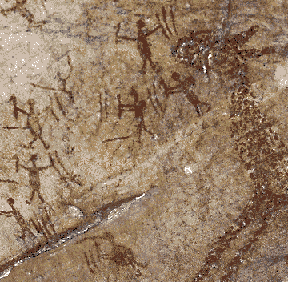 dustry (using quartzite, flint,
chalcedony, and quartz) very rich in quantity, but the number of tool types
is restricted and generally not too elaborated. They had a nearby raw material
source and did not conserve it. Only flint was used with parsimony. We also
found a piece of horn transformed into a perforator. dustry (using quartzite, flint,
chalcedony, and quartz) very rich in quantity, but the number of tool types
is restricted and generally not too elaborated. They had a nearby raw material
source and did not conserve it. Only flint was used with parsimony. We also
found a piece of horn transformed into a perforator.
Fig.4: Scene from Toca do João Arsena of people with spears
and spearthrowers, and large animal at right. This is an example of the middle
phase of the Nordeste Tradition of rock painting at Serra da Capivara
(photo: FUMDHAM).
Since the lithic artifacts are very simple, with few pieces elaborated or
showing very good technique, Claude Guérin thinks that they were not
able to hunt big animals such as the giant sloth, sabertooth cat, and mastodon.
But they had lots of horses and paleo-llamas and aquatic birds. As the region
is a geological boundary, it presented several different ecosystems and offered
very diversified natural goods and raw materials. If Eden existed it was
here! By the way, we also have thousands of snakes!
Claude
Guérin: At Antonião, some artifacts resembling those
from Pedra Furada are associated with megafauna (figs.5). People of that
period were certainly not specialists in hunting large game because their
weapons were too primitive, and 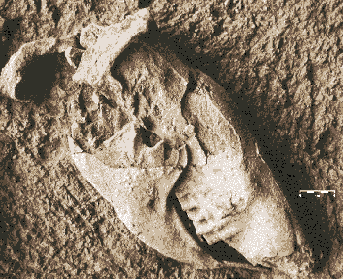 besides, we have never found a butchery site.
These were hunter-gatherers who took what they could find byhappenstance,
and who must have scavenged a lot of carrion because the animal remains are
both very abundant and very varied. besides, we have never found a butchery site.
These were hunter-gatherers who took what they could find byhappenstance,
and who must have scavenged a lot of carrion because the animal remains are
both very abundant and very varied.
As for “Garrincho Man,” he must have been trapped in the site in
the same way as the animals because they are closely associated. Moreover,
we have not found a single artifact in this deposit.
Fig.5: Fossilized giant sloth skull from Toca da Janela da Barra
do Antonião, one of many Pleistocene cave sites in the same karstic
area as Pedra Furada (photos: courtesy Claude Guérin). AR:
Among the tools shown in your (1986) Nature article are those
termed “blunt points” (fig.6). What kind of function might these
have had? Is this lithic terminology partly derived from Old World usages
on Mousterian or other kinds of points? If so, do you think there has been
any misunderstanding of the details of your site due to a use of Old World
terminology?
Niède Guidon: We suppose that these points were used
to make holes in wood, leather and, as some of them have retouched sides,
they were also probably used as scrapers. People had the same needs all o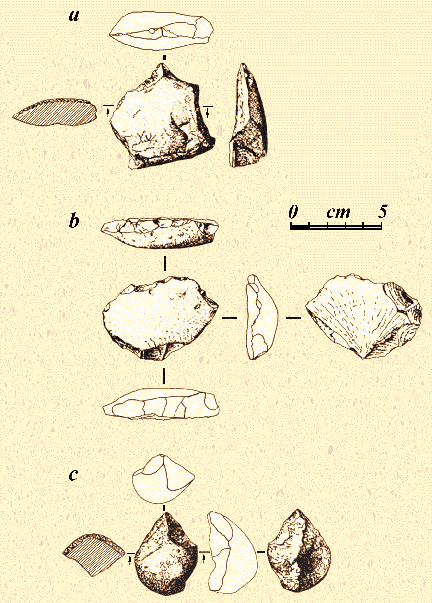 ver
the world and the same genetic heritage so the answers to the different problems
they faced were more or less the same. Yes, I always use the same terminology
used in France, why not? It does not mean that the technological evolution
in America was the same as in Europe. The climate was different so the needs
also are different. But two lithic pieces with the same morphology may have
the same names, I think. ver
the world and the same genetic heritage so the answers to the different problems
they faced were more or less the same. Yes, I always use the same terminology
used in France, why not? It does not mean that the technological evolution
in America was the same as in Europe. The climate was different so the needs
also are different. But two lithic pieces with the same morphology may have
the same names, I think.
Fig.6: Three of the 560 artifacts recovered from Pedra Furada 1 up
through 1986 in layers dating from before 32,000 to about 25,000 BP: a)
retouched, notched point on a quartz flake; b,c) blunt points or scrapers
with up to 4 convergent flake scars, with traces of utilization (from
Guidon and Delibrias 1986, p.771; FUMDHAM).]
. AR: Some have proposed that the earliest Pedra Furada charcoal
dates may be from natural fires (cf. Meltzer, Adovasio, and Dillehay 1994).
Why do you think your findings, which seem very compelling, have not been
fully accepted by some other New World archaeologists who have found preClovis
sites?
Niède Guidon: I cannot understand why. Perhaps because
when you are the first to discover something, people want to kill you because
you disturbed the placid waters of the lake. The theories on the peopling
of America are only theories, and in prehistory it is not possible to say
that something does not exist only because we do not find them. A theory
is not a law, but may and must be changed each time new facts are discovered.
And I am sure of our discoveries because our team is very good with specialists
in different sciences. I have degrees in both Natural History and Prehistory,
and decades of fieldwork. I know when I am digging a place where people placed
stones in order to make a fire inside the structure, and when I am facing
a natural fire. And forest fires were not common events in the rain forest
before the arrival of white men.
Fabio Parenti: Essentially for three reasons: a) lack of detailed
publications; b) the very peculiarity of such old dates, with poor
“undisputable” evidence; c) lack of direct participation in the
field effort of an international team (isolation of Brazilian archaeologists).
Rock Paintings at Pedra Furada:
AR: How old are these rock paintings, and how have they been dated?
Anne-Marie Pessis: The rock art in Brazil, and in South America
in general, is not as old as that in Europe, although in some cases this
is challenged. The data available up to now suggest that some paintings in
northeast Brazil date to around 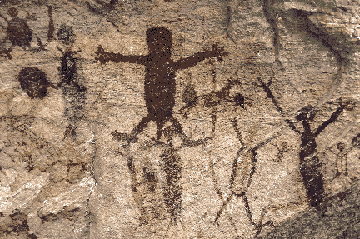 12,000 years BP. These have been grouped
into the “Nordeste [Northeast] Tradition.”
Dating for the Nordeste Tradition was established from cliff fragments with
rock art discovered in archaeological strata, thereby dating the panel’s
detachment from the walls of the shelter. 12,000 years BP. These have been grouped
into the “Nordeste [Northeast] Tradition.”
Dating for the Nordeste Tradition was established from cliff fragments with
rock art discovered in archaeological strata, thereby dating the panel’s
detachment from the walls of the shelter.
Fig.7: Human and animal figures including deer at Toca da Extrema
II (photo: FUMDHAM).
Direct dating of paintings is not common in Brazil. In Europe, by contrast,
painters often used pigment containing a high proportion of carbon which
can be directly radiocarbon dated, thus producing some old dates. However,
by using other methods in the Serra da Capivara National Park, we do have
several cases of reliable dating of paintings. One example, dated by associated
stratigraphy, was discovered during excavations at Toca do Baixão
do Perna shelter.Charcoal from the top of a hearth found in the sediment
layer that covered the wall with paintings gave dates of 9,650 +/- 100 BP
(Beta 32972), and the charcoal from the bottom of the hearth, 20 cm below
the painted figures, was dated 10,530 +/- 110 BP (Beta 32971).
At another site, Toca da Ema do Sítio do Brás, two big blocks
with several figures belonging to the Nordeste Tradition spalled from the
wall, falling to the ground. Afterwards, sediments covered them until they
were discovered during excavation of the site when we just turned them over
and found the figures. The charcoal from these sediments was dated from 9,290
to 9,000 BP (calibrated; Beta 148100).
As a third and older example, excavations at shelter Toca do Boqueirão
da Pedra Furada yielded a little piece of the wall on which some lines had
been drawn with
red ink, that lacked any diagnostic traits of the Nordeste Tradition. Charcoal
from a hearth found in the same strata gave dates of 29,860 +/- 650 years
BP (GIF 6651). So we can affirm that at least 29,000 years BP prehistoric
people in this area prepared pigments that could be used 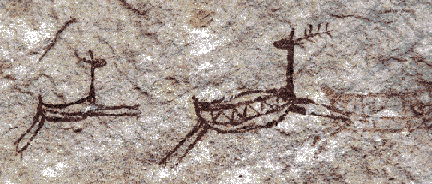 for different purposes,
and that they used them to make abstract or non-representational designs
- signs, geometrical figures. It is possible that at first these drawings
were made only for fun, without any social significance, but what is sure
is that they did prepare and use these pigments on them. for different purposes,
and that they used them to make abstract or non-representational designs
- signs, geometrical figures. It is possible that at first these drawings
were made only for fun, without any social significance, but what is sure
is that they did prepare and use these pigments on them.
Fig.8: Painting of deer from Toca das Figuras do Angical I (photo:
FUMDHAM).
Niède Guidon: In 1991 Prof. Baffa from the Physics
Department of the University of São Paulo at Ribeirão Preto,
dated a layer of calcite that was covering two red anthropomorphic figures
at the site Toca da Bastiana (fig.3). The calcite dated to 17,000 years old.
In 2000 Prof. Shigueo Watanabe from the Physics Department of the University
de São Paulo at São Paulo, dated by TL and ESR the calcium
oxalate of the same calcite at 30,000-40,000 BP. Dr. Marvin Rowe from Texas
A&M University, however, dated the oxalate crust in 2,540 +/- 60 years
BP. So there we have a big problem. We are now excavating the shelter, and
we found 2 burials. We are waiting for the dates of these burials. We also
have some samples of charcoal pigments from the Pedra Furada rock art at
the laboratory of Gif in France waiting to be radiocarbon dated by the AMS
method. Until now it has been impossible to directly date the pigments.
AR: In terms of style, how do the paintings correspond to anything
that has been found elsewhere in the world, contemporaneous or not? Do they
seem to have a strong psychological dimension such as that in some Amazonian
art?
Anne-Marie
Pessis: In the National Park and particularly in the shelter Toca
do Boqueirão da Pedra Furada there is a sample of the whole Nordeste
Tradition evolution. It begins with the oldest figures, which were the first
paintings on the rock walls, through the ones that show the evolution of
the techniques, the themes and the scenography, till the figures of the last
period after which they disappeared completely, suddenly, silently without
any record of a conflict, or genocide or integration with another new cultural
group. The main characteristic of the Nordeste Tradition are the narrative
figures that represent actions of daily life as well as ceremonial events
(figs.7-9). It’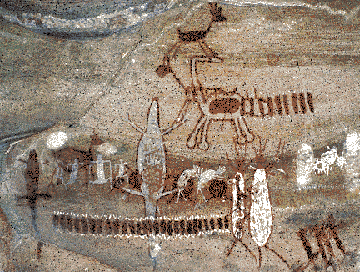 s possible to find in the world other groups that used
the narrative themes in their rock art. The paintings of the Spanish Levant
present some stylistic similarities in the human and animal figures with
the Nordeste Tradition. But the big difference is the way the components
of the message are presented, how the figures are chosen and assembled on
the wall, the technical devices they used to represent time and the space
and the techniques of perspective. s possible to find in the world other groups that used
the narrative themes in their rock art. The paintings of the Spanish Levant
present some stylistic similarities in the human and animal figures with
the Nordeste Tradition. But the big difference is the way the components
of the message are presented, how the figures are chosen and assembled on
the wall, the technical devices they used to represent time and the space
and the techniques of perspective.
Fig.9: Detail of rock painting in a niche at Toca do Boqueirão
da Pedra Furada, showing people and animals including crocodiles, a puma,
deer and llamas (photo: FUMDHAM).
The non-identified figures are abstract forms with a universal character
that may be perceived and used by all the members of the human species,
independently of their cultural origins. They may have differences in the
drawing techniques, in the morphology, and complexity, but they have similarities
all over the world.
AR: What materials and techniques were used to create the petroglyphs
at Pedra Furada? Were any pigments utilized other than charcoal, and the
ochre mentioned in the 1986 Nature article?
Anne-Marie Pessis: The pigments used in the rock art were prepared
with ochre and clay of different colors, very common in the rock formations
near the shelters. These sources of raw material were used for millennia.
The ochre, or iron oxide, was the most used pigment, so the red color is
the most frequent in several different tones, from the very faint to deep
red. These tonalities were obtained through mixture of different pigments
- red, yellow, orange, and brown - and by heating the pigments at different
temperatures and humidity.
Other colors were also used in the rock art of the Nordeste Tradition, such
as yellow, white, black and gray. Chemical analysis has shown that in some
cases, burned bones were used to make the black pigment, but there is not
enough organic material to date it.
Some very thin lines that were made by the Nordeste Tradition demanded some
very skillful drawing techniques. They learned how to prepare the pigment
to obtain the exact consistency needed to paint the areas they wanted, without
having the colors leach down. The irregularity of the sandstone rock surface
didn’t help to make very tiny and delicate figures.
They used various techniques to prepare the pigments. The excavations at
the shelter Toca do Sítio do Meio uncovered a piece of sandstone with
a central concavity where there are water erosion marks and some grooves
produced by an instrument. It was a palette covered with red pigment, used
as the painter’s palettes of today. Associated charcoal was radiocarbon
dated to 8,920 +/- 50 years BP (LY 10134).
The first tools used to make marks on the rocks were the fingers. But prehistoric
people had to discover instruments that replaced the use of the hands in
order to be able to make very delicate drawings. Nature offered fibers, the
hairs of animals, and the spines of plants like the cactus (Cactaceae). These
were the first instruments people used to make the drawings, looking for
a way to translate their mental images into these material images.
AR:
What is the sequence of change over time (in style, preservation, materials
used, etc.) in the petroglyphs at Pedra Furada?
Anne-Marie Pessis: The class of rock art we call the Nordeste
Tradition seems to have lasted in this region over a period of 6,000 years
in a non-stop process of stylistic evolution. The oldest rock art in the
National Park is characterized by the dynamic nature of the figures and
represented scenes. Human and animal illustrations show play activity (actions
ludiques) with the subjects caught at the maximum point of the action, whose
theme can be recognized (fig.10). The variability of the compositions are
extreme and create an air of unity to the painted panel.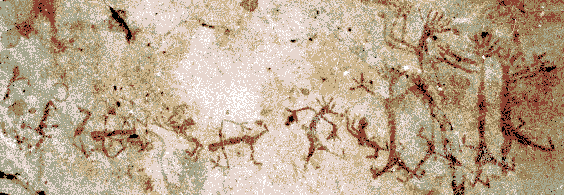 Fig.10: Example of actions ludiques, in a rock painting
at Toca do Veado showing dancing figures (photo: FUMDHAM).
As time passed, coinciding with the growth of the population, it’s possible
to perceive a diversification of the paintings in the themes as well as in
the techniques and rules of graphic presentation. This is a transitional
period, where artists attempted many different and more perfect ways to represent
time and space. These transformations on the rock art, however, did not change
the identity of the original figures.
During this
period of graphic transitions, we infer corresponding demographic changes
with a multiplication and diversification of groups, and the establishment
of new cultural identities. These seem to create circumstances of confrontation
and divergences, prior to the appearance of a new social, territorial and
ecological equilibrium. Population increase in the territory and resulting
cultural differentiation create rivalries and quarrels, reflected in the
rock art with the appearance of new themes. Scenes representing violent themes
are characteristic of this transition (fig.21). But, at the same time, there
are several demonstrations of technical improvements and a more complex
scenography.
In the final phase of this transition process, a new system of graphic
presentation appears in which the ornamentation appears privileged, and
r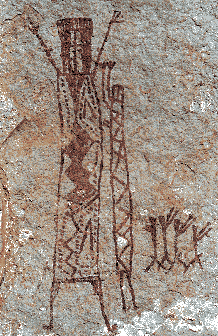 epresented with so high a degree of detail and precision that it is possible
to perceive individual differences between the figures (fig.11). These figures
have different morphologic patterns than earlier in the Nordeste Tradition
and are framed on rectangular forms, covered by ornaments, but beside all
these changes the original characteristics of the Nordeste Tradition are
still present. The most important trait of this final period is a tendency
to keep the message hermetic; the figures are more emblematic and different
than in earlier phases. Each one of the three moments of the stylistic evolution
of this tradition have eponymous sites with a very clear dominance of each
one of the graphic profiles. epresented with so high a degree of detail and precision that it is possible
to perceive individual differences between the figures (fig.11). These figures
have different morphologic patterns than earlier in the Nordeste Tradition
and are framed on rectangular forms, covered by ornaments, but beside all
these changes the original characteristics of the Nordeste Tradition are
still present. The most important trait of this final period is a tendency
to keep the message hermetic; the figures are more emblematic and different
than in earlier phases. Each one of the three moments of the stylistic evolution
of this tradition have eponymous sites with a very clear dominance of each
one of the graphic profiles.
[Fig.11: Example of the final Nordeste Tradition phase depicting
rectangular human forms and ornamentation, from Toca do Morcego (photo:
FUMDHAM).]
. Research and Educational Facilities at Parque Serra da
Capivara:
AR: We understand you are working with The Capivara National Park
to promote education and tourism of Pedra Furada and its surroundings. Can
you explain more about your program, including the museum on early people
in South America, and what our readers can expect when they visit?
Niède Guidon: The Brazilian government commissioned
our foundation, FUMDHAM, to prepare the management plan of the National Park
Serra da Capivara and to define the policies for its protection. The sites
of the Park are on the UNESCO list of the sites of the World Heritage. We
understood that it is impossible to preserve culture and nature when people
living nearby are poor and ignorant. So we developed a conservation program
based on the social and economic development of the region, through education
and health. Working in association with the National School of Health, Instituto
Oswaldo Cruz, we built 5 schools all around the park. These schools are different
from the public schools in Brazil; the kids come at 7 AM and stay in school
until 5 PM, and they receive meals and health care. In the morning they have
normal official class and in the afternoon they have sports and art (music,
theater, movies, dance).
We built all the structures in the National Park - roads, Visitors’
Center, paths, rest areas, and 103 shelters with paintings prepared to receive
visitors without endangering the paintings or the archaeological strata (fig.30).
We bought 3,000 hectares adjoining the Park and prepared the architectural
plans for a Hotel Resort and an Archaeological Park, named Arkeopolis. The
international airport Serra da Capivara will be finished in 2002.
We have a huge structure: museum, laboratories, offices, theater, and auditorium
in the town of São Raimundo Nonato. At the field nearby the National
Park Serra da Capivara we have a Visitors Center, 5 schools and 3 farms where
we are breeding wild animals.
AR: How should potential visitors get in touch with you and with
the museum (i.e. email, website address, or fax)?
Niède Guidon: Anyone interested should write:
Fundação Museu Do Homem Americano (FUMDHAM); Fundação
Seridó, Av. Boa Viagem 5212, Ana Nery, 816., Recife 51030-000; Brazil.
Email: fumdham@terra.com.br or trilhascapivara@uol.com.br. Web
address: www.fumdham.com.br Fax: 55 89 582 12 93
Telephone: 55 89 582 16 12
. .
References:
Bird, M.I., L.K. Ayliffe, L.K. Fifield, C.S.M. Turney, R.G. Cresswell, T.T.
Barrows and B. David. 1999. “Radiocarbon dating of ‘old’ charcoal
using a wet oxidation-stepped combustion procedure.” Radiocarbon
41(2):127-140.
Fifield, L.K., M.I. Bird, C.S.M. Turney, P.A. Hausladen, G.M. Santos, di
Tada 2001. “Radiocarbon Dating of Human Occupation of Australia prior
to 40 ka BP - Sucesses and Pitfalls.” Radiocarbon 43(2):1139-1145.
Fladmark, K. 1979. “Routes: Alternative Migration Corridors for Early
Man in North America.” American Antiquity 44:55-69.
Gruhn, R. 1994. “The Pacific Coast Route of Initial Entry: An
Overview.” In R. Bonnichsen and D.G. Steele (eds.) Methods and Theory
for Investigating the Peopling of the Americas. pp.249-256. Corvalis, Center
for Study of the First Americans, Oregon State Univ.
Guidon, N., and B. Arnaud. 1991. “The chronology of the New World: Two
faces of one reality.” World Arch. 23(2):167-178.
Guidon, N. and Delibrias, G. 1986. “Carbon-14 dates point to man in
the Americas 32,000 years ago.” Nature 321:769-771.
Meltzer, D.J., J.M. Adovasio and T.D. Dillehay. 1994. “On a Pleistocene
human occupation at Pedra Furada, Brazil.” Antiquity 68:695-714.
Morales, Reinaldo 2002. Website on the Nordeste Tradition.
http//www.geocities.com/sotto/workshop/ 7724/nordeste2.html.
Parenti, F. 1996. “Questions about the Upper Pleistocene Prehistory
in Northeastern Brazil: Pedra Furada Rock Shelter in its Regional Context.”
Proceedings of the International Meeting on the Peopling of the Americas.
São Raimundo Nonato, Piauí, Brazil, Fumdhamentos, 1(1):15-53.
Peyre, E. 1993. “Nouvelle découverte d’un Homme
préhistorique américain: une femme de 9,700 ans au
Brésil.” Comptes Rendus de l’Académie des Sciences
de Paris t. 316, Série II, p.839-842.
Peyre, E., C. Guérin, N. Guidon, et Y. Coppens. 1998. “Des restes
humains pléistocènes dans la grotte du Garrincho, Piauí,
Brésil.” Comptes Rendus de l’Académie des Sciences
de Paris 327, série II, 335-360.
Peyre, E., C. Guérin, N. Guidon, et Y. Coppens. 2000. “Resultados
da datação de dentes humanos da Toca do Garrincho, Piauí,
Brasil.” Clio-série Arqueológica nº 14 - Anais da
X Reunião Científica da SAB. Universidade Federal de Pernambuco
2000, Recife, Brasil, 75-86.
Santos, G.M., M.I. Bird, B. Pillans, L.K. Fifield, B.V. Alloway, J. Chappell,
P.A. Hausladen and A. Arneth. 2001. “Radiocarbon dating of wood using
different pretreatment procedures: Application to the chronology of Rotoehu
Ash, New Zealand.” Radiocarbon 43(2):239-248.
Stanford, D. 1999. “Iberia, not Siberia.” Paper presented at the
Clovis and Beyond Conference, Santa Fe, New Mexico.
Turney, C.S.M., M.I. Bird, L.K. Fifield, R.G. Roberts, M. Smith, C.E. Dortch,
R. Grun, E. Lawson, L.K. Ayliffe, G.H. Miller, J. Dortch, and R.G. Cresswell.
2001. “Early Human Occupation at Devil’s Lair, Southwestern Australia
50,000 Years Ago.” Quaternary Research 55:3-13.
This article appears on pp. xx-52 in Vol.3, No.2 of Athena
Review.
.
|
|